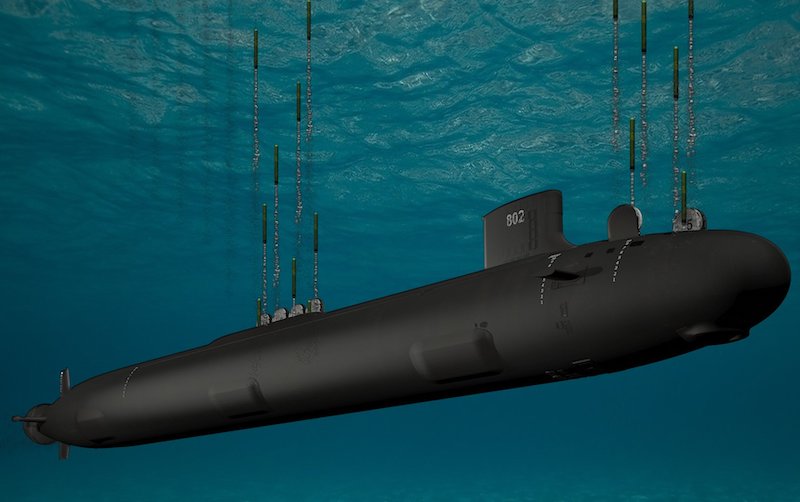Navy New Virginia Block VI Virginia Attack Boat Will Inform SSN(X) (Re: USNI News)
In the News

The submarine community is nearing a plan for its Block VI Virginia-class submarine, which will be an improvement in stealth and capability compared to the boats under construction today and will be a bridge to the upcoming SSN(X) program.
The Block V Virginia submarines – the first three of which have already begun construction – represent the first time the Navy has made a major investment in increasing the capability of this class of ship. Whereas past blocks have focused on construction and maintenance efficiencies, and incremental capabilities are added through software updates regularly, the Block V design adds 28 more missile tubes to greatly enhance the strike capability of these SSNs, Program Executive Officer for Submarines Rear Adm. David Goggins said this week at the Naval Submarine League annual symposium.
Block VI will continue that trend of adding new capability and lethality to the boats, which will be procured in a multiyear contract from Fiscal Years 2024 through 2028.
“Block VI will focus on building upon the acoustic superiority” technology that’s being built into and tested on the future South Dakota (SSN-790), as well as “really enable that organic subsea, seabed warfare kit release for the first time.”
Specifically, he said the Navy and industry are working on improved stealth to operate in a contested environment; enhanced sonar performance through a new bow conformal array; and the ability to sense and interact with more of the water column, including the sea bed.
Goggins said those ideas have been chosen as priorities for Block VI for two reasons: first, they’ll improve the capability of the Virginia class in the near term, and second, they’ll help prove out technologies that could influence the next-generation SSN(X) design.
“We’ll spend the next year evaluating the maturity and feasibility of these capabilities [on the slide he presented], followed by a downselect next year. And that will really allow us to mature the technology,” Goggins said.
Goggins’ slide also highlighted propulsors, improved payload and vehicle hosting, improved situational awareness and additional payloads as features of the Block VI design.
Elsewhere during the Sub League event, it was clear that the rest of the submarine force is eagerly eyeing the SSN(X) program and what kinds of improvements are within the realm of the possible for that program.
Vice Adm. Daryl Caudle, commander of Naval Submarine Forces and Submarine Force Atlantic, said during his presentation that SSN(X) could be based on the Virginia design, could be based on the Columbia-class ballistic missile submarine (SSBN-826) design, or could be a clean-sheet design.
“We’re going to get alternatives and make decisions on how to make this new SSN match what we need to stay ahead of our peers. This is definitely going to be increased speed: there’s no question that speed is basically important to improve every single joint warfare function. Speed is just so important – it plays out so well in all our wargaming, so it helps compensate for bad decisions, it also helps us get to the fight faster and helps us in all-domain maneuver warfare,” he said.
“We can never get enough payload capacity, so we do want submarines with large payload capacity. And what’s that going to look like in the future and how’s it going to be modular and customizable is going to be important. Of course, stealth is important, but not just acoustic stealth. It’s stealth across all spectrums. When this new SSN rolls out, we are going to have peer competitors that are going to be able to detect us not just acoustically but through algorithms that are going to break the water interface. And so those capabilities, we think, are coming, and we have to build and basically remain clandestine with those types of capabilities in play.”

Adm. Frank Caldwell, the director of the Naval Nuclear Propulsion Program and a senior submarine officer in the Navy, echoed in his remarks the three design options and said that “key in all of this will be our focus on speed, warfighting capability, greater energy, lethality and sensors, and, yes, the next level of stealth. I want you to know that we are working on this very actively as an enterprise.”
USNI News previously reported that the Navy may be leaning towards a Columbia-like hull for its next attack submarine. With the much wider diameter comes the ability to achieve greater speed and stealth. An SSN(X) design like this would be reminiscent of the Seawolf design – which was used for just three submarines as the Cold War was winding down but is considered the Navy’s most capable attack sub.
In a separate presentation during the event, Congressional Research Service naval affairs specialist Ron O’Rourke said, “I remember one person in public describing the Seawolf-class as a boat that was designed to go up into the Soviets’ backyard and do a lot of damage before it had to come home to be rearmed – and so it was designed to be a fairly fast submarine and heavily armed, especially compared to the Los Angeles-class design of the day. So in light of the Navy now talking about this next-generation attack boat being fast and heavily armed, it would not be surprising, as some people have speculated, if that submarine were to have a diameter similar to that of the Seawolf or the Columbia-class design, something in the range of 40 to 43 feet.”
If that were to be the case, he said, SSN(X) might have a similar diameter to Seawolf but a greater displacement, due to modernization in engineering such as the SSN(X) likely having a larger electric drive system instead of a mechanical one.
Written By: Megan Eckstein
